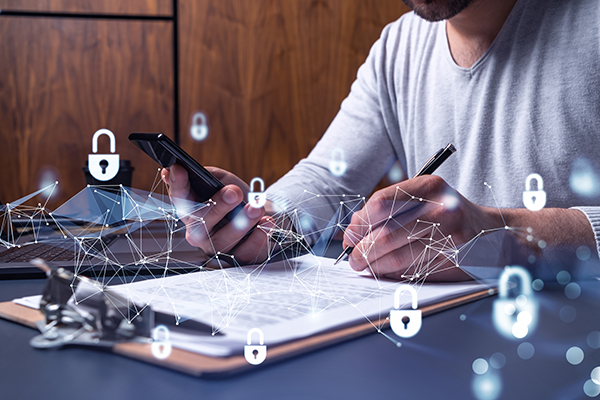In today’s digital age, electronic payments have become the norm due to the convenience they offer. However, the use of checks remains relevant in many business transactions. Nevertheless, there is an increasing rise in check fraud. The National Check Fraud Center estimates that the frequency of check fraud will continue to increase by 25% annually.
As a CEO and close observer of modern financial systems, I have noticed a disturbing upturn in fraudulent activity within the financial services industry. In the wake of Silicon Valley Bank’s (SVB) collapse, this trend is especially concerning as people now lack confidence in banking security, leaving them vulnerable to malicious parties.
In today’s digital age, electronic payments have become the norm due to the convenience they offer. However, the use of checks remains relevant in many business transactions. Nevertheless, there is an increasing rise in check fraud. The National Check Fraud Center estimates that the frequency of check fraud will continue to increase by 25% annually.
Thus, it is of the utmost importance to exercise caution when using checks today. As more and more businesses increasingly rely on checks as a form of payment, protecting against fraud should be top of mind.
Organizations need to be aware that criminals can use incredibly sophisticated methods to commit financial crimes, and checks are perhaps at the greatest risk as they travel from one hand to another. The most effective measure to ensure check security is for companies to minimize their reliance on them by switching to digital payments whenever possible.
Other methods, such as additional authentication requirements and establishing secure processes that protect sensitive information, are also recommended.
Payment Check Frauds: Most Common Occurrences
Counterfeit Checks
As an observer of modern financial systems, I can confidently say that counterfeit checks fraud is a growing issue in the industry. Although there may be ways to spot a fake check – suspicious routing numbers or typos, for example – it can be tough to catch them all. My best advice is not to accept payment through check unless you know the source well enough to trust that the funds are good.
Otherwise, you run the risk of having your account balance directly affected if one of these fraudulent checks gets deposited into your account. It’s crucial to stay vigilant and protect our financial accounts from these malicious activities.
Alteration
As a CEO, I’ve seen my fair share of fraudulent checks. Alteration fraud is one of the most common methods used to commit this type of crime. These fraudsters are able to change the payee, amount, or even the date on a legitimate check in order to benefit themselves.
They can use chemicals or other methods to make the check appear legitimate, but in actuality, they are using forged information to go unnoticed while taking money from victims. Fortunately, there are many measures that banks and businesses can take to ensure these criminals don’t succeed.
Forgery
Another piece of advice I can offer is to be vigilant and always check the signature against known examples of the account holder’s handwriting. Additionally, scanning each document and creating digital records is an important practice that helps prevent forgery. Last but not least, having a good system in place to identify red flags on suspicious transactions can help to stop forgery fraudsters in their tracks – meaning companies avoid significant losses.
Stolen Checks
Stolen checks can be a painful reminder of the dark corners of the digital age. I’ve heard countless stories about individuals who have fallen victim to stolen and fraudulently used checks. Such cases usually involve a check book or individual checks taken from a mailbox, home, or even someone’s bank account, as fraudsters take advantage of printing checks with their victim’s information. It all goes to show just how important it is today to remain vigilant against such crimes.
Steps To Protect Yourself Against These Frauds
Securing Your Checks and Bank Info
CEOs and financial experts, including me, understand the importance of protecting against check fraud. To achieve this, it is imperative to keep your checks and bank information secured. There are several steps you can take to ensure that your checks do not fall into the wrong hands.
First, make sure to never write checks in public places and always check the address to who you are sending the check. Next, avoid pre-printed checks as much as possible, since they might contain incorrect payable names and addresses. Additionally, store all important documents, such as account numbers in a secure location that is hidden away from plain sight.
Lastly, it is equally important to stay informed of any suspicious activity related to your accounts by regularly reviewing your statement for any irregular activity or payments.
Fraud Detection and Prevention Services
To protect against check fraud, companies must prioritize security in their vendor payment methods. ACH payments provide a safer alternative to checks as they reduce the risk of fraud and data breaches and are faster, more reliable, and cheaper.
It is essential that businesses don’t just switch to ACH payments, but also incorporate other measures to combat check fraud risk. One such measure is a dual control system for ACH payments which requires two or more approvals for payment processing by multiple employees.
This improves security as it eliminates single points of vulnerability. Moreover, it allows employees to detect suspicious activity more quickly and efficiently, thus reducing the time between identification and resolution if any discrepancies occur.
Secure Networks and Encryption Technologies
One of the most important steps to protect yourself against check fraud is to use secure networks and encryption technologies when transferring sensitive data. This can include financial information, such as account numbers, routing numbers, etc., that is vulnerable to unauthorized access.
Companies should also practice separation of duties in their payment processes to further reduce the chance of fraud. With this approach, different people are assigned to initiate transactions, approve them, as well as reconcile them, which ensures no single individual has absolute control over the process.
Start by securing all systems in your workplace and educating your workforce about phishing, ways in which work emails can be compromised and how to prevent that, and more. Plus, shift payment methods from paper-based to digital using ACH.
Both secure networks and encryption technologies coupled with designated duties and digital payments can create strong preventative measures for companies so that they can stay protected from unwanted frauds and breaches in security protocols.
Summing it Up
The bottom line is checks remain the main source of fraud – 74% of scam attempts are based on them. But you can protect your business accounts with electronic payment methods Рintegrated controls and procedures can be used to generate reports and create clear audit trails. Plus, electronic transactions are easier to make and ensure vendors receive funds quickly thus reducing risk of fraud significantly.
In conclusion, combating counterfeit checks is an integral part of running a financially stable and secure business. Following the above advice on modern financial systems on fraudulent checks will help you identify, authenticate, and counteract fraudulent check activities.
By keeping up-to-date on current check fraud trends, implementing technological solutions, and adopting employee training programs, you can prevent significant financial losses. It is your responsibility as a business owner to remain vigilant and protect your finances from fraudulent check activities.






